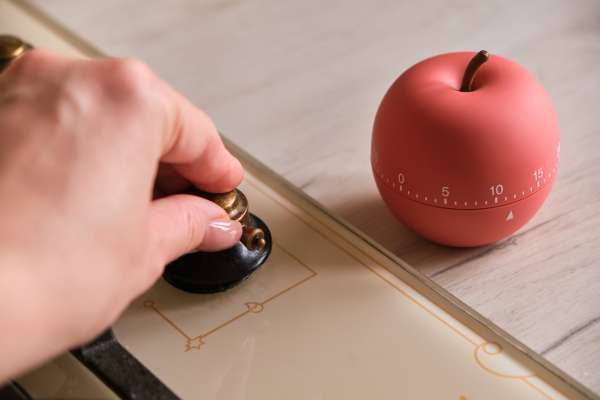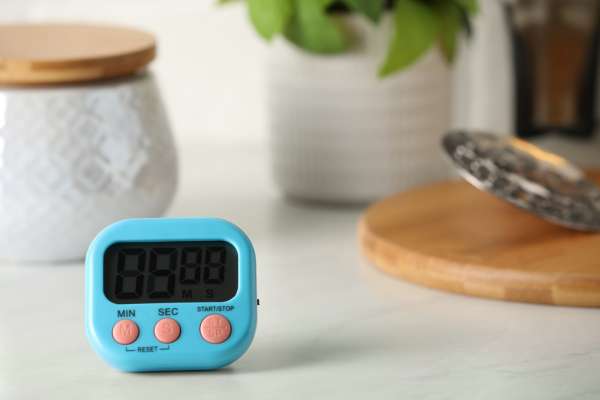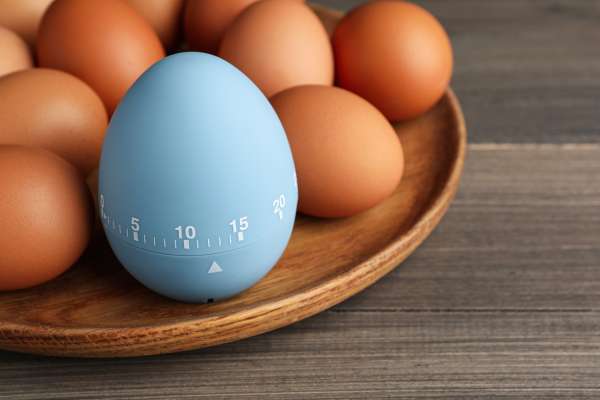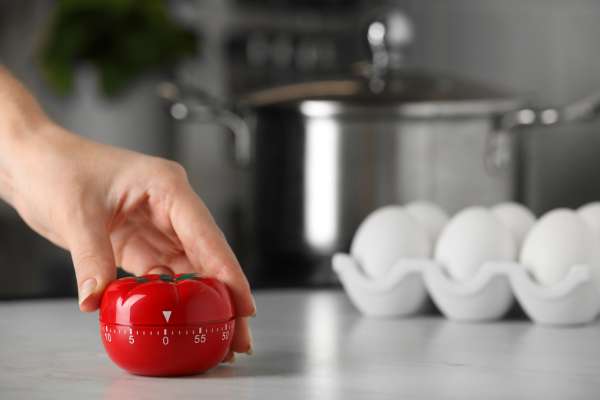The unassuming kitchen timer Work is a marvel of engineering simplicity designed to assist cooks in managing time-sensitive culinary tasks effectively. Typically, kitchen timers operate on either mechanical or digital principles, providing users with a reliable means of tracking and managing cooking durations. Mechanical timers use gears, springs, and other mechanical components to count down time, emitting an audible signal when the set time elapses. On the other hand, digital timers leverage electronic circuits and displays, offering precision and user-friendly interfaces. The functionality of both types involves a calibrated mechanism that ensures accuracy in timekeeping, making them indispensable tools for anyone striving for culinary perfection.
How Long Do Kitchen Timers Usually Last?
The longevity of kitchen timers varies depending on factors such as usage frequency, quality of construction, and the type of timer. Mechanical timers, with their durable mechanical components, can often withstand extensive use and may last for several years. Digital timers, with their electronic components, also boast a commendable lifespan but may be susceptible to wear and tear over time. Regular maintenance and handling with care can extend the life of a kitchen timer, ensuring that it remains a reliable companion in the kitchen for an extended period.
Are Smart Kitchen Timers Worth The Investment?
In the era of smart technology, the concept of a smart kitchen timer has emerged, promising enhanced features and connectivity. The decision to invest in a smart kitchen timer depends on individual preferences and needs. Smart timers often offer programmability, connectivity to mobile devices, and additional features like voice commands. For tech-savvy cooks who value convenience and integration in their kitchen appliances, a smart kitchen timer may prove to be a worthwhile investment. However, traditional mechanical and digital timers continue to be reliable and cost-effective options for those who prefer simplicity and functionality without the bells and whistles of smart technology.
Types Of Kitchen Timers
Kitchen timers come in various types, each catering to different preferences and cooking styles. Mechanical timers, characterized by their classic ticking sound and analog dials, offer a nostalgic charm and reliable functionality. They are simple to use and do not rely on batteries, making them a timeless choice. Digital timers, featuring LCD or LED displays, provide precise countdowns and often include additional features such as multiple countdowns and memory functions. The choice between mechanical and digital timers ultimately boils down to personal preference and the specific needs of the cook, as both types excel in fulfilling the primary purpose of timely and accurate countdowns in the kitchen.
The Countdown Mechanism

At the heart of every kitchen timer lies the countdown mechanism, a fundamental feature that distinguishes it as a reliable timekeeping tool. Whether employing the traditional ticking gears of a mechanical timer or the electronic precision of a digital counterpart, the countdown mechanism serves As the pulse of this indispensable kitchen device. This mechanism operates by meticulously tracking the elapsed time, gradually approaching the pre-set countdown duration. As the seconds tick away, the countdown mechanism silently works in the background, ready to announce its completion with A distinctive alarm, signaling the moment For culinary attention. The seamless integration of this mechanism ensures that cooks can orchestrate their culinary endeavors with precision, turning time into a manageable and audible ally in the kitchen.
Kitchen Timer Features

Beyond the essential countdown mechanism, kitchen timers often boast additional features designed to enhance their usability and cater to diverse cooking needs. One prominent feature is the array of alarm sounds, allowing users to personalize their auditory experience when the countdown concludes. From classic beeps to melodic tones, the choice of alarm sound adds a touch of customization to the cuisine timer, making the conclusion of a countdown a personalized and engaging moment. Another valuable feature is the capability for multiple countdowns, enabling cooks to manage various cooking processes simultaneously. This multitasking functionality is especially beneficial for those engaged in complex recipes or orchestrating a feast, providing a versatile timekeeping solution for the dynamic demands of the kitchen. Together, these features elevate the cuisine timer from a mere timekeeping device to a tailored and adaptable assistant in the culinary domain.
Setting and Adjusting Timers

Setting and adjusting timers are fundamental skills in the kitchen, ensuring precise control over cooking durations and preventing overcooking or undercooking of dishes. For traditional mechanical timekeepers, users manually turn the dial to the desired time, aligning it with the indicator. Digital timers typically feature user-friendly interfaces, allowing cooks to input specific times with the push of a button. Some advanced timekeepers even offer touchscreen controls or voice activation for seamless adjustment. Understanding the nuances of setting and adjusting timers empowers cooks to tailor their culinary processes with accuracy, transforming the kitchen timer into a personalized timekeeping assistant.
Inside a Digital Kitchen Timer

The inner workings of a digital kitchen timer reveal a combination of electronic components that collaborate to provide precision in timekeeping. A microcontroller processes the user’s input and initiates the countdown, while an LCD or LED display communicates the remaining time. The timer’s internal circuitry ensures accuracy, and some models may include additional features such as memory functions or programmable settings. Exploring the internal mechanisms of a digital cuisine timer unveils the synergy of technology and functionality, showcasing how these devices seamlessly integrate modern innovation into the art of culinary time management.
Smart Kitchen Timers

In the era of smart homes, cuisine timers have evolved to embrace connectivity and intelligent features. Smart kitchen timekeepers often connect to mobile devices through apps, allowing users to monitor and control timers remotely. Voice activation further simplifies the user experience, enabling hands-free operation. Additionally, some smart timers integrate with other smart cuisine appliances, creating a cohesive and automated cooking environment. While traditional timekeepers remain reliable, smart kitchen timers cater to those seeking enhanced convenience and integration in their technologically advanced culinary spaces.
Maintenance and Care

Ensuring the longevity and optimal performance of a kitchen timer requires regular maintenance and careful handling. For mechanical timers, periodic lubrication of gears and springs can prevent friction and ensure smooth operation. Digital timekeepers, being electronic, benefit from proper battery management and protection from moisture. Cleaning the exterior regularly preserves the timer’s appearance and functionality. Whether mechanical, digital, or smart, reading and following the manufacturer’s maintenance guidelines is crucial. By investing time in the care of cuisine timers, cooks can prolong their lifespan and continue to rely on these timekeeping companions for countless culinary adventures.
Kitchen Timer Innovations

In the dynamic landscape of kitchen gadgets, innovations in cuisine timers have introduced exciting features and functionalities. Some modern timekeepers incorporate Bluetooth connectivity, allowing users to control and monitor the timer through a dedicated mobile app. Touchscreen displays, gesture controls, and intuitive interfaces provide a user-friendly experience. Additionally, there are timers equipped with sensors that can detect the doneness of food, ensuring perfectly cooked meals. These innovations reflect a commitment to enhancing the user experience in the kitchen, transforming the humble timer into a sophisticated and indispensable tool for culinary enthusiasts.
Kitchen Timer Hacks

Beyond their conventional use, kitchen timers have inspired creative hacks that extend their utility in the kitchen. One popular hack involves repurposing timers as a reminder for various household tasks, from watering plants to taking breaks during work. Another ingenious use is deploying timekeepers for portion control or as a tool to regulate study or work intervals. Some cooks use multiple timers simultaneously to synchronize different components of a meal, optimizing efficiency. These inventive timer hacks showcase the versatility of this essential cuisine tool, proving that its usefulness extends far beyond the realm of cooking.
Testimonials
Culinary enthusiasts worldwide have attested to the transformative impact of kitchen timekeepers on their cooking experiences. Testimonials highlight the reliability and convenience of timers in achieving consistent and precise results. Users praise the innovative features of modern timers, such as programmability and connectivity, as game-changers in the kitchen. The testimonials also emphasize the timer’s role in instilling confidence in both novice and seasoned cooks, enabling them to tackle complex recipes with ease. As a testament to their significance, cuisine timers have garnered a loyal following, with users expressing gratitude for the stress-free and enjoyable cooking experiences facilitated by these timekeeping companions.
What Should I Do If My Timer Stops Working?
Encountering a non-functional kitchen timer can be frustrating, but there are several troubleshooting steps to consider before replacing it. Firstly, check the batteries in the case of digital or electronic timers, as depleted batteries are a common culprit. Clean the battery contacts and ensure they are properly inserted. For mechanical timers, inspect the gears and springs for any obstructions or damage. If these steps do not resolve the issue, consulting the manufacturer’s instructions for specific troubleshooting guidance is advisable. In some cases, timers may have a reset button or other mechanisms to address malfunctions. If all else fails, it may be time to consider a replacement, keeping in mind the diverse options available in the market.
Are There Timers Specifically Designed For Baking?
Absolutely, there are timers specifically tailored to meet the unique requirements of baking. Baking often involves multiple steps with varying timeframes, and precision is key to achieving perfect results. Baking timekeepers typically come with features such as countdown and count-up functionality, allowing bakers to keep track of rising times, proofing periods, and overall baking durations. Some timers also include pre-programmed settings for common baking tasks like bread proofing or cake baking. The design of these timekeepers often considers the hectic nature of a busy kitchen, providing bakers with a reliable tool to ensure their creations are baked to perfection.
Conclusion
In the realm of culinary precision, the kitchen timer stands as a steadfast ally, facilitating the orchestration of diverse cooking endeavors. Whether it’s the classic ticking of a mechanical timer, the digital precision of modern counterparts, or the smart features of cutting-edge innovations, these devices play a crucial role in ensuring that time becomes an asset rather than a constraint in the kitchen. From troubleshooting non-functional timers to exploring specialized options for baking, understanding the nuances of these timekeeping tools empowers cooks to elevate their culinary experiences. In the end, a reliable kitchen timer proves to be more than just a gadget; it becomes a dependable companion in the pursuit of culinary excellence.
